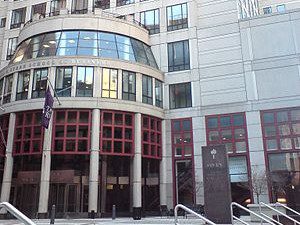Friday Morning News & Notes: LBS Wins Again, Traffic Tax And The Kelley Online MBA

Good morning and happy Friday!
Here are a few stories you may have missed from the week that was …
Friday Morning News & Notes: Immoral Profits, Warby Parker and The NFL Draft

Good morning and happy Friday!
Here are a few stories you may have missed from the week that was …
Admissions Tip: Welcome Weekends

It’s April, which means that the majority of leading programs will be hosting business school welcome weekends for those candidates that they have admitted during their first two admissions rounds. These “sell” weekends are very important for the schools as part of their push to encourage those that they have admitted to enroll. They know that many of their admitted students have options to go elsewhere, or are now considering the financial aspects of the program and concerned as to whether it is an economically viable option.
If you were fortunate enough to gain admissions to an elite MBA program, this post is for you. We explain the importance of attending welcome weekends and what you should want to learn.
What Are The Best Philadelphia Executive MBA Programs?

The intoxicating allure of the Executive MBA promises better pay, enhanced skills and a shortcut on your up to the higher rungs of the corporate ladder. For those looking to make a career on the East coast, what are the best Philadelphia Executive MBA programs to look out for?
Financing Your MBA, Part I

As more and more of you are receiving your admissions results from all your hard work during the MBA application process, we wanted to turn our attention to how you’ll manage financing your MBA.
If you’ve got a spare couple hundred thousand dollars in your bank account, then you can probably skip this series. For everyone else, read on. In this post and a handful to follow, we’ll provide a broad overview of the various costs a typical MBA student faces and the types of funding opportunities currently available. Down the line, we’ll take a closer look at the financial aid processes at a diverse range of leading business schools, giving you the tools you need to assess MBA programs in light of both your own goals and available financing options.
If you’re just beginning to think about an MBA, this series can help map out the landscape, outlining the financial aid process and resources available at various programs. You can extend your research by consulting the Clear Admit School Guides and schools’ own websites, as well as through conversations with current students.
First Things First: What’s an MBA Going to Cost?
The first step in financing the MBA is getting a handle on how much it will cost. The primary expense of an MBA program is tuition. Having said that, there are a variety of other costs—including living expenses, course materials and additional fees—that can increase the total amount a student pays by a half again. Most business schools provide a breakdown of the expenses, which are posted under the financial aid or admissions section of their websites in order to help prospective students seriously consider the cost of completing a particular MBA program. Schools typically take the total cost of attendance into account when calculating the financial aid package students receive.
Tuition
Tuition at the top business programs has risen steadily for decades, often at a rate above inflation. Students can now expect to pay between $50,000 and $75,000 for a single year’s tuition at a top school, with an average total price tag of $130,000 for tuition alone. Public universities, which discount tuition for state residents, can sometimes be more affordable. For instance, in-state residents attending schools such as UT Austin’s McCombs and UNC’s Kenan-Flagler pay about $15,000 less in tuition each year than do out-of-state residents. The range of variance of costs that in-state residents pay can be explained in part by the different levels of subsidies that public universities receive and the economies of the states in which they are located.
Living Costs
The cost of living also forms a substantial part of a student’s expenses while at business school. These costs typically cover housing, food, utilities and other personal expenses, and they can vary widely by geographic region. For example, the Fuqua School of Business, located in the college town of Durham, North Carolina, estimates that students will pay $12,800 for room and board in their first year. Meanwhile, at NYU Stern, located in the center of Manhattan in New York City, the estimated cost for room and board is $25,170.
Living costs are usually based on surveys of the student population or estimates of local rental costs. Students should keep in mind that the figures posted by most schools are for single students with no dependents; those with partners or children should take into account the additional expenses of balancing family life with full-time studies. Harvard Business School, for instance, estimates that students with a spouse or partner should set aside an additional $16,900 in yearly expenses for a spouse or partner, another $13,100 for one child and an additional $8,500 for a second child. Meanwhile, Tuck, with its rural New Hampshire campus, calculates that $7,500 should be set aside for each additional family member. Prospective students with further questions may contact their target programs’ financial aid offices in order to request information about expected family expenses.
Additional Expenses and Fees
Course materials, healthcare insurance, transportation costs and other mandatory university fees can add several thousand dollars to a student’s expenses each year. For example, Wharton’s Pre-term fee is $2,000. Furthermore, extracurricular activities, particularly international trips that are often a highlight of an MBA experience, can substantially increase costs; for example, the Kellogg Worldwide Experience and Service Trips (KWEST) run into the thousands before considering a number of additional out-of-pocket expenses. To help cover these expenses, some schools allow students to apply for an increase to their cost of attendance and thereby take on more loans.
Loan Interest
Because recent legislature has rendered federally subsidized loans unavailable for U.S. citizens or permanent residents in graduate school, students relying on loans to fund their studies will see their interest accumulate while in business school. For the most part, students do not have to start paying that interest, or the principle, until several months after they graduate. Federal loans and some private loans also include an ordination fee that is tacked on to each loan disbursement. We’ll go into greater detail on loans in a later post in this series.
Stay tuned for future posts in this series, where we’ll take a closer look at the range of financing options available to MBA students—including school-based financial aid, private scholarships and loan programs—as well as specific resources for international students.
7 Takeaways from the 2018 U.S. News Business School Ranking

The schools making up the top 10 in this year’s U.S. News & World Report ranking of the nation’s best MBA programs—released today—were exactly the same as last year. That said, there are a smattering of surprises in terms of how top schools rose and fell relative to one another—and in movement among schools outside of the top 15.
At quick glance, here are this year’s top 10, in order of their 2018 rank (2017 rank in parentheses):
1 Harvard Business School (1)
1 University of Pennsylvania’s Wharton School (4)
3 University of Chicago Booth School of Business (2, tie)
4 Stanford Graduate School of Business (2, tie)
4 MIT Sloan School of Management (5, tie)
4 Northwestern’s Kellogg School of Management (4, tie)
7 UC Berkeley Haas School of Business (7)
8 Dartmouth’s Tuck School of Business (8, tie)
9 Yale School of Management (8, tie)
9 Columbia Business School (10)
With today’s release, students, alumni and administrators at Harvard Business School (HBS) can toast their school’s third consecutive showing at the top of the list. But the University of Pennsylvania’s Wharton School has even more cause for celebration, having tied HBS for first this year. It’s only the second time in 28 years it has claimed the No. 1 spot. It’s also an important rebound for the Philadelphia school, which fell to fourth last year as it was surpassed for the first time ever by the University of Chicago Booth School of Business.
Chicago Booth isn’t letting up, though. It took third place this year after tying Stanford for No. 2 last year. After never having cracked the top three before, Booth’s now done it two years in a row.
Perhaps the biggest news among the top 10—and the farthest fall from grace—was Stanford Graduate School of Business (GSB)’s slide into a three-way tie for fourth place with MIT Sloan School of Management and Northwestern’s Kellogg School of Business. Stanford has never before not clocked in at least third or above in the U.S. News ranking.
Rounding out the top 10 were Haas, Tuck, Yale and Columbia—very similar to last year except that Yale slipped slightly, from a tie at eighth with Tuck to a tie this year at ninth with Columbia. It’s a slight gain for CBS, meanwhile, which last year was 10th, behind Tuck and Yale in a tie for eighth.
7 Key Takeaways from the 2018 U.S. News MBA Ranking
We’ve sifted through the data and compiled a summary of things worth taking notice of this year:
1) Wharton Is the Year’s Big Winner
Wharton has traditionally been considered part of the “holy trinity” of schools, behind only HBS and Stanford in many people’s eyes. That made last year’s fourth-place finish behind Chicago Booth a real blow.
This year, the school fought back—seizing a shared claim to first place for only its second time ever. Strong employment and pay figures—85.6 percent of graduates employed at graduation and the highest reported average salary of all schools, $155,058—helped significantly.
“This is excellent news for Wharton—especially after last year’s showing in the U.S. News ranking and, more broadly speaking, in light of the constant (and not always positive) media attention the school has garnered due to controversial alum, President Trump,” says Graham Richmond, Clear Admit’s co-founder. “While many will quip about employment figures and how they favor the likes of HBS and Wharton vs. Stanford, the key—from Wharton’s perspective—is being squarely back in the ‘trinity,’” adds Richmond.

Booth School of Business
2) Booth Stakes Its Claim in the Top Three
Last year, Chicago Booth tied Stanford for second place—its first time ever outranking Wharton and also the first time the Chicago school had secured a top-three spot in the history of the U.S. News rankings.
Making it into the top three for a second year in a row helps dispel any notions of last year being a fluke. A climbing GMAT average (726) and high employment numbers (84.9 percent employed at graduation) have played a part in its rise.
3) Methodology Disadvantages Stanford
Because U.S. News’ methodology relies on “grades” from corporate recruiters and other employment stats that favor larger firms over startups or entrepreneurial pursuits, schools with large numbers of students going into tech startups or entrepreneurship—such as Stanford—are essentially penalized. Stanford may be further hurt—at least in terms of the U.S. News list—by the fact that its graduates are confident enough that they’ll land a plum job that they can be a little choosier about which offers they accept. Indeed, only 62.8 percent of its MBAs were employed by graduation—as compared to 85.8 percent at Wharton, 84.9 percent at Chicago Booth and 79.3 percent at HBS.
Of course, Stanford came out ahead in terms of average GMAT/GRE scores (737), average undergraduate GPA (3.73) and overall student selectivity. With an acceptance rate of just 6 percent, it was by far the most selective school of all those ranked, with HBS accepting 10.6 percent, Wharton, 19.6 percent, and Chicago Booth, 23.6 percent. But these factors are given less weight than peer assessments and corporate recruiter survey scores as U.S. News crunches its data.
4) Yale SOM Defends Its Position in the Top 10
This year marks the third time since 2013 that Yale School of Management (SOM) has ranked in the top 10, giving the school an increasingly legitimate claim to membership in this elite club. In this most recent ranking, the New Haven school tied for No. 9 with CBS. Last year it tied at eighth with Tuck—a five-spot jump over the previous year.
Yale has been making improvements on several fronts. In 2011, the school hired Dean Edward Snyder—the very same dean who sat at the helm of Chicago Booth during its meteoric rankings rise in the early 2000s. Yale has also been poaching high-profile faculty from other schools over the last decade, including Andrew Metrick, professor of finance, and Anjani Jain, current assistant dean, both formerly Wharton faculty.
Add to that the opening of glittery new facilities in 2014 and the school’s traditional strength and reputation as a leader in the non-profit and corporate responsibility areas—currently in vogue with millennials—and the school’s continued top-10 showing makes sense.
5) Columbia Regains a Spot, Sort of
CBS is battling to maintain its top-10 claim, and its tie this year with Yale for ninth is theoretically an improvement over its 10th place finish last year. But it’s still down from the No. 8 spot it successfully defended from 2012 through 2016. Contributing factors could include the rising cost of living in New York and declining interest among applicants in the financial sector—but that’s just conjecture.
As we noted last year, CBS is one of only a few schools in the top 10 that haven’t recently unveiled a new building or substantially expanded their facilities, which could be a liability. Construction is underway for an impressive new Manhattanville campus, but its projected completion date has been pushed off from the original 2018.
Yale’s moving into—and remaining in—the top 10 has also exerted downward pressure on CBS.
6) NYU Stern Gets Its Scores in on Time, Bounces Back from 20 to 12
Last year’s biggest shock was NYU Stern’s plummet from No. 11 to No. 20. But as U.S. News noted at the time, the reason for Stern’s sharp decline was the fact that it didn’t get its GMAT/GRE scores in on time. When it did get the scores in, U.S. News refused to recalculate the rankings.

NYU Stern
The drop of nine spots on the list did seem harsh—and pretty implausible. Indeed, this year’s No. 12 showing seems much more legit for the traditionally top-15 school—suggesting it got its scores in on time this year.
Again, Clear Admit’s Graham Richmond weighs in: “Last year’s NYU Stern/U.S. News rankings fiasco did not paint U.S. News in the best of lights. It felt like a petty slap on the wrist aimed at Stern and served to raise questions about the validity of the rankings, which were arguably no longer accurate where a key school was concerned. While it is nice to see things seemingly back to ‘normal’ this year, the issue highlighted the perils of a straight ordinal ranking that some suspect can be tweaked to sell magazines, rather than a tiered ranking that represents the true matriculation behavior we see among applicants seeking an MBA.”
7) Movers and Shakers Elsewhere in the Ranking
Of course, there are many business schools beyond the top 10. U.S. News ranked 131 schools in total. Further down in the rankings you see some more precipitous gains and losses. On the plus side, Arizona State University’s W. P. Carey School of Business and USC’s Marshall School of Business both cracked the top 25. Carey jumped 10 places to 25th, from 35th last year. Marshall moved up seven spots to come in just ahead of Carey at 24th.
The University of Virginia’s Darden School of Business slipped three spots to 14th, it’s second consecutive year of decline. Vanderbilt’s Owen School of Management also took a hit, dropping from 22nd to tie with Carey at 25th. Falling out of the top 25 altogether was Rice University’s Jones Graduate School of Business, which dropped to No. 29. This, despite its 11-spot leap to eighth place in Bloomberg BusinessWeek’s November 2016 ranking.
This article has been edited and republished with permissions from Clear Admit.
